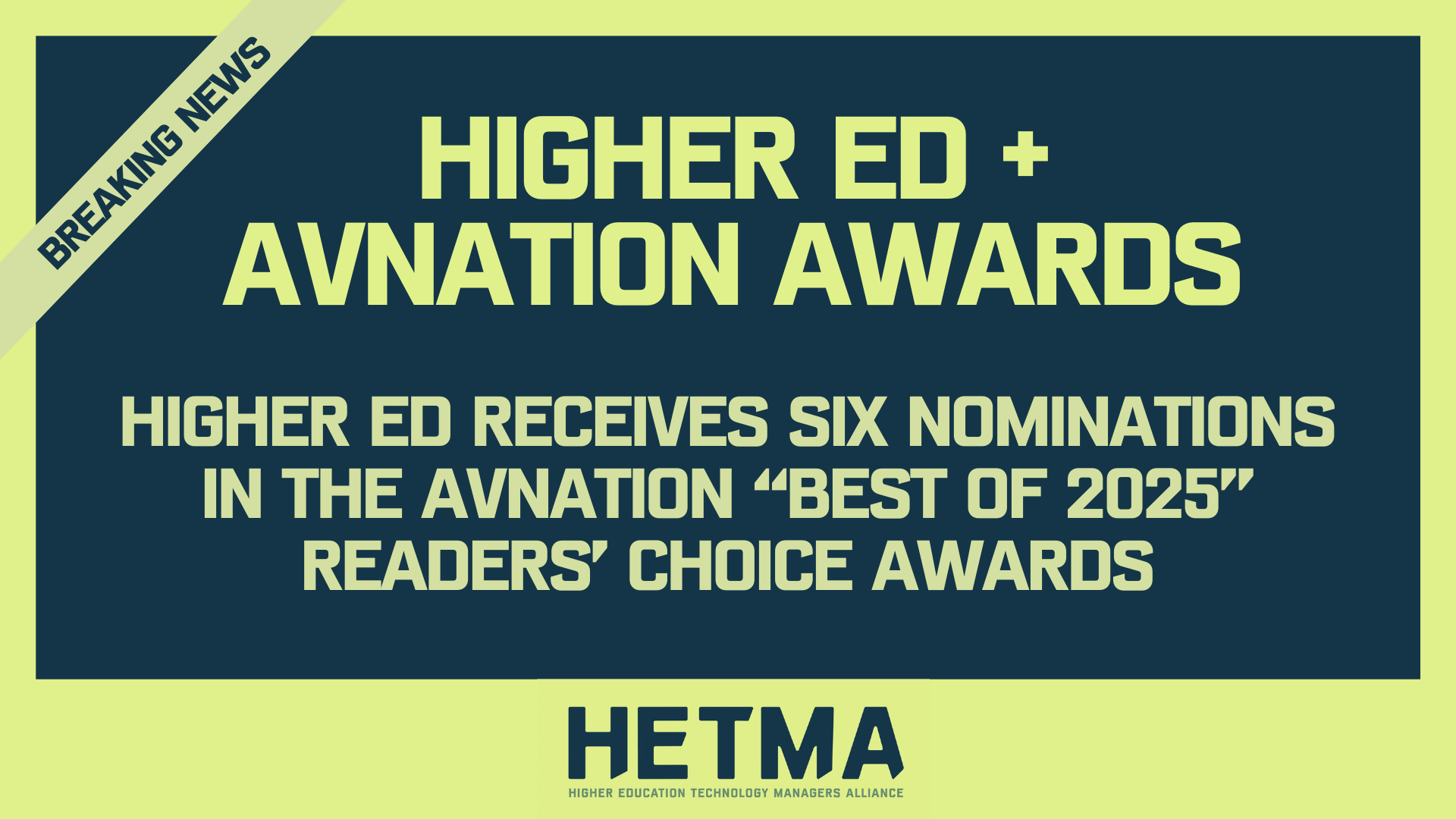Introduction:
Recently I gave a presentation on what I thought was the future of AV in Higher Education and how to get there. When I saw this month’s theme I felt the presentation would fit well within the theme. I took my presentation and expanded it so it was less focused and covered more of higher education. Now before we go into details I am aware that some schools might be doing things now that I see as the future. This article again is to try and tackle higher education as a whole.
TimeLine:
We cannot take a look at the future until we understand where we came from.
This means we need to take a quick look at the past as well as the present. After we talk about the past and the present I will then take a look at the near future, which I see as 1 to 3 years down the road, as well as the far future which I see as 4+ years down the road.
Past: Sage on The Stage
The sage on the stage model has a fixed or semi-fixed location for the presenter to give their presentation from, a display, or two, in the front of the room, with the audience sitting in fixed or semi-fixed seating which all faced the same direction. Sage on the stage was designed for the presenter to provide information to the audience. In this model, there is little to no interaction from the audience except for in the form of questions and answers. In the past these rooms would be stand-alone systems, meaning they would not be connected to the enterprise’s network. This design would require a rack full of equipment to provide all the things the presenter might need for their presentation. You would find a video switcher, DSP, amplifiers, displays, and even power supplies. If the space is a larger space there could even be speech reinforcement. All this equipment would need to be out of sight. They could be hidden in a large oversize podium, in an AV closet, or an AV rack located in the room. Also, the programming for these spaces was limited to the manufacturer’s equipment that was installed in the space.
Past: Active/Flip Learning
The active/flip learning environment changes the sage on the stage by allowing more calibration between the presenter and the audience. They also allow the presenter to use different locations to present from, they are no longer limited to being in the front of the room but now can be in different locations throughout the room. With the presenter being in different locations of the room, they can make a better connection with all the students in the classroom. Being able to change the furniture also allows for the audience to calibrate with each other and even take an active part in the presentation.
Just like the sage on the stage, these spaces would be stand-alone systems in the past. They require a matrix system to handle all the different video and audio inputs in the space. Having the flexibility to use the room how the presenter would like, increases the need for training on the room. Due to the complexity of these spaces most rooms do not get used as they were designed, also troubleshooting issues become harder as there are more points of failure, programming the space becomes complex and makes the user’s interface complicated. With all these complexities these active/flip learning spaces become another sage on the stage but with a higher cost.
Present: Enterprise Connected Systems
Now that we took a quick look at the past let’s take a look at the present. Taking the sage on the stage and active/flip learning spaces and connecting them to the Enterprise network allows the AV team to provide remote support and remote monitoring. These remote options allow the AV team to provide quick support to a user which limits the amount of time the user is waiting for help. Also, remote monitoring allows the AV team to see issues before the users find them. If the AV team is aware of issues, they can address them before the user even enters the space. With less downtime and a quicker response time, the AV team provides reassurance to the faculty that when they walk into a space the equipment is going to work for them.
Entering onto the enterprise network does come with its challenges. One challenge is that the AV team will need to learn more IT skills such as networking. When rooms were stand-alone systems, they were either not connected to a network or were connected to an isolated network. This meant that the AV team did not need to know terms such as VLANs or firewalls. Now that equipment is being connected to the enterprise network, the AV team not only needs to understand these networking terms but also needs to take security into consideration. We are seeing an increase in security issues related to AV; the latest two being Adobe Flash and Log4Shell. With more AV equipment entering the enterprise network they become just another node onto the network. These nodes need to follow along with the security policies put in place by the security team so they do not become low-hanging fruit for hackers.
Present: Hyflex
Due to COVID, Hyflex took off across college campuses. Schools needed to be able to still provide quality education while students, faculty, and staff were all sitting at home. This moved the AV team to focus their attention on providing audio and video connections for faculty and staff in their offices or homes. When schools were permitted to have students back on campus they still needed to follow COVID guidelines. Some of these guidelines meant that they needed to spread the students out in classrooms. To achieve this, these schools had to find ways to still provide education to their students that might be spread out. This is where the AV teams started planning.
Hyflex spaces allow faculty to teach to more students while also following the guidelines in place. Students could be in the room, at home, in their dorm room, at a coffee shop, or even in a different room on campus. Another benefit to Hyflex classrooms is faculty can now provide synchronous and asynchronous. These can be achieved now cause the AV team installed cameras, microphones, recording units, and larger displays for remote students.
Near Future: AVoIP
Now let’s take a look into the near future. There are schools that are already rolling out AVoIP but it’s not widely accepted just yet. AVoIP stands for AV over Internet Protocol. AVoIP provides the flexibility and scalability that schools are looking for. Schools can also decrease the amount of equipment they need to install in each space while also providing flexibility and scalability. Being able to route the audio and video from any source to any display across the network makes AVoIP a promising technology for schools. If a new display or a new source needs to be added to a space the AV team no longer is limited by the number of fixed inputs/outputs of the matrix switcher; they just need to put the extra transmitter or receiver box on the network and update the code to reflect this change. Also, with the option of Power over Ethernet (PoE), there is no need to make sure there are enough power outlets at the location which helps reduce the number of cables and equipment needed.
Now, AVoIP does have some concerns to take into consideration. I wrote about AVoIP for my November 2021 Higher Education article and it was even featured on SDVoE Live. In the article, I discuss things like security, PoE power budget, QoS, and IGMP. These terms might be new for the members of the AV team but are not new for the networking or security teams.
How can the AV team gain more knowledge in these areas?
There is a good amount of education path they can take. AVIXA is expanding the classes they offer which cover AVoIP as well as networking and some security. In fact, the last InfoComm I took an education session on Zero Trust. Now I knew about Zero Trust before but I never thought about how to apply it to AV. After leaving that session I have been thinking about how to apply Zero Trust to our AV equipment. Also, the CompTIA Net+ and Security+ are two education classes that are geared for IT but AV can take advantage of them as well. These courses do take having the funds to pay for them so there are also free options as well. For example, the HETMA virtual conference is another good source of education. HETMA’s membership is free for anyone in higher education and when they develop their virtual conference they do it a little differently than other conferences. HETMA does not put a call out for presentations but they have an open discussion with their membership to find out what the members want to learn. Once they have what the membership wants to learn then HETMA finds the SMEs in those areas to provide the training.
Near Future: Software Define AV
The IT world is becoming more software-driven and there is no reason why AV in higher education can not follow suit. Being able to deploy AV solutions via software allows for scalability, flexibility, lower cost, security, and not being confined to special hardware. Software such as Zoom and MS Teams allow the AV team to provide an easy-to-use UC platform that can run on almost any device. Leveraging common computer languages like HTML5 and Python allows for lite weight AV programs to run on almost any device and still provide reliable control. With it being just software, the school can easily change the platform without a big investment. This allows the schools to change platforms if needed, without losing the standards they already built. With Software Define AV the life cycle of upgrading classrooms change from 5/7 years to anytime the software receives an update.
How do we get to a software define AV?
First, it will take a change in mindset for the AV programmers. Programmers enjoy writing code so moving to a software development mindset should not be a stretch for the AV programmer. Also, this opens the door to recruit software developers from the IT field. Just like AVoIP, software define AV brings the AV more into the IT fold.
Far Future: Cloud Services
A future service that Software Define AV can leverage is Cloud Services. Just like AVoIP and Software Define AV, Cloud Services can provide scalability, flexibility, lower cost, security, and not be limited to special hardware. Cloud Services also allows for a dedicated support team for the backend as well as accessing services anywhere there is a network connection. Cloud Services platforms have dedicated teams who are reasonable for making sure systems are up, patched, and secure. Leveraging these teams allow the AV team to turn their focus back onto the experience in the classrooms.
How do we get to leveraging cloud services for our AV environment?
I suggest setting up a sandbox environment. Having a sandbox environment will allow the AV team to test and learn cloud services without impacting current operations. Once the sandbox environment is running correctly, the AV team can be confident with it, and rolling it out across campus would be the next step. With the flexibility and scalability of cloud services, this rollout doesn’t even need to be all or none. Having the sandbox and cloud services also allows the AV team to test out features without impacting the classrooms. They can even roll out these features on-demand and if an issue comes up roll back to the previous configuration with a click of a button.
Far Future: Metaverse
The second far future is the Metaverse. When I talk about Metaverse I am not talking about Facebook changing their name to Meta or that everyone will be wearing headsets. I am talking about the immersive environment that the Metaverse brings. This might mean wearing headsets or might mean accessing a virtual classroom like SecondLife, from any device the user has. The impact the Metaverse will have on higher education is still not fully determined but the more developed and define it becomes the more promising it looks. The Metaverse can even help with accessibility as students who might have a disability and are uncomfortable sharing it publicly can use the Metaverse to feel comfortable in their environment and take an active part in their education.
How do we get to the Metaverse in higher education?
As I mentioned earlier, the impact of the Metaverse is still in the early development but like all the other future trends the Metaverse will require building relationships with teams outside of AV. With the Metaverse being everywhere we need to make sure our network and network team can handle the increased demand. We need to work with the security team to make sure that not only are our platforms are secure but also that our students, faculty, and staff are protected. Also, the AV team will need to work with the Teach and Learning team to make sure the content is being developed and the facilities team to build these immersive environments.
Conclusion:
No matter what the future holds for AV in Higher Education the only way we can get there is by expanding our circle of knowledge and building relationships. I will end this article with a quote I feel sums up the importance of relationships.
Numerous studies in social psychology have demonstrated that people establish the most collaborative and longest-lasting connections when they work together on tasks that require one another’s contributions.
the Harvard Business Review ‘Learn to Love Networking’ “








